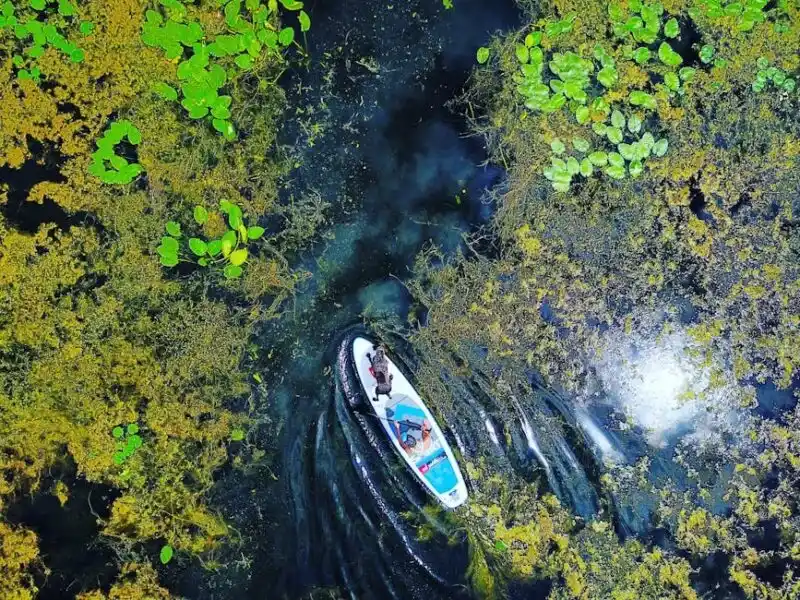SUP for Beginners and Tips to Get Started

Paddleboarding: Your Guide to Gliding on Rivers and Lakes
Hey there, water lovers! Ever dreamt of walking on water? Well, stand-up paddleboarding (SUP) on rivers and lakes is the closest you’ll get (without any actual magic involved). It’s a fantastic way to connect with nature, get a bit of a workout, and have a whole lot of fun. So, grab your board, and let’s dive in!
Why Rivers and Lakes are Awesome SUP Spots
Forget the crashing waves of the ocean (for now!). Rivers and lakes offer a unique paddleboarding experience:
- Calm Waters, Easy Learning: Lakes, especially, provide flat, calm water perfect for beginners. You can focus on balance and paddling technique without battling waves. Rivers offer a bit more challenge, but gentle stretches are still great for learning.
- Scenic Views: Imagine paddling down a winding river surrounded by lush greenery or gliding across a crystal-clear lake reflecting the mountains. Rivers and lakes offer stunning scenery and a peaceful escape from the everyday hustle.
- Exploration and Adventure: Rivers offer a sense of adventure, allowing you to explore hidden coves, discover wildlife, and navigate different currents. Lakes provide opportunities for longer paddles, exploring shorelines, and even picnicking on secluded beaches.
- Fitness with a View: Paddleboarding engages your core, arms, and legs, providing a full-body workout without feeling like you’re stuck in a gym. And let’s be honest, the view is way better!
Choosing the Right Gear

Before you hit the water, you’ll need the right gear:
- The Board: Inflatable SUPs are a popular choice for rivers and lakes due to their portability and durability. They’re easy to transport and can handle bumps and scrapes against rocks or branches. Rigid boards offer better performance and stability but are less convenient to transport.
- The Paddle: An adjustable paddle is essential for finding the right length. A paddle that’s too short or too long can make paddling inefficient and tiring.
- Life Vest (PFD): Safety first! Always wear a personal flotation device (PFD), especially on rivers with currents.
- Leash: A leash keeps your board attached to you if you fall off, preventing it from floating away. This is crucial on rivers with currents.
Safety Tips for River and Lake Paddleboarding

While paddleboarding on rivers and lakes is generally safe, it’s essential to follow these safety tips:
- Check the Weather: Avoid paddling in strong winds, storms, or when there’s lightning.
- Be Aware of Currents: On rivers, be aware of the current and avoid strong currents or rapids if you’re a beginner.
- Know the Water Conditions: Check for underwater obstacles like rocks, logs, or debris.
- Tell Someone Your Plans: Let someone know where you’re going and when you expect to be back.
- Paddle with a Buddy: It’s always safer and more fun to paddle with a friend.
Getting Started: Tips for Beginners

- Start on Calm Water: Begin on a calm lake or a slow-moving section of a river.
- Practice Getting On and Off: Practice getting on and off your board near the shore until you feel comfortable.
- Learn Basic Paddling Techniques: Learn the forward stroke, sweep stroke (for turning), and reverse stroke.
- Start on Your Knees: Begin by paddling on your knees to get a feel for the board’s stability. Once you feel comfortable, slowly stand up.
- Relax and Enjoy: Most importantly, relax and enjoy the experience! Paddleboarding is a great way to de-stress and connect with nature.
Beyond the Basics: Taking it to the Next Level
Once you’ve mastered the basics, you can try some more advanced activities:
- S U P Yoga/Fitness: Combine the benefits of paddleboarding with yoga or fitness exercises.
- S U P Fishing: Enjoy a unique fishing experience from your paddleboard.
- Long-Distance Paddling: Explore longer stretches of rivers or lakes on multi-day trips.
So, what are you waiting for? Grab a board, find a local river or lake, and experience the joy of paddleboarding! You might just discover your new favorite way to explore the water.



